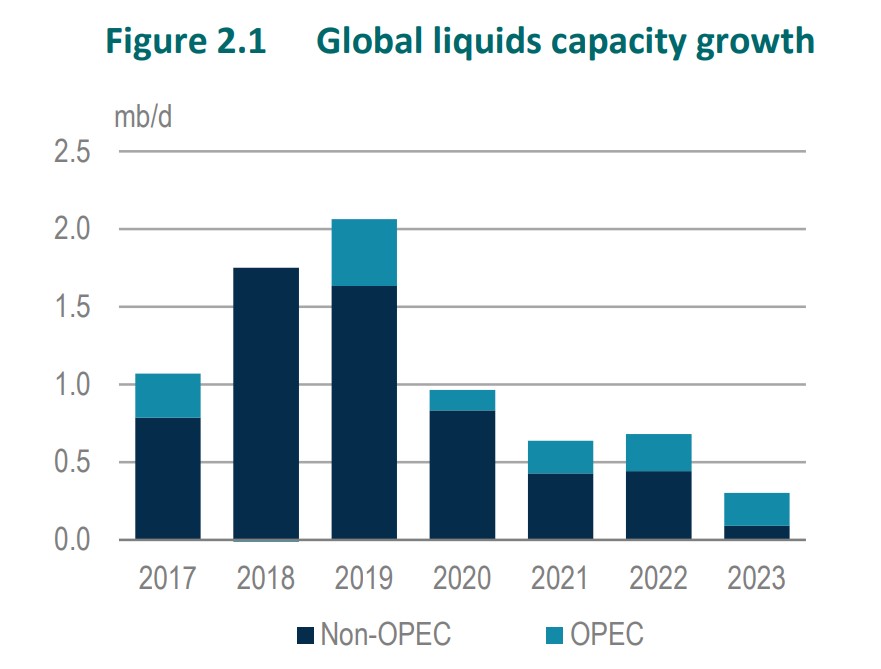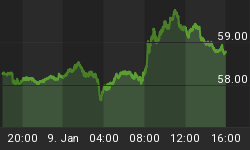Monday, March 5, 2018
Volatile trading continues in stock markets amid concerns about President Trump fomenting a trade war. A tweet from the president on Saturday alluded to tit-for-tat trade reprisals. “If the E.U. wants to further increase their already massive tariffs and barriers on U.S. companies doing business there, we will simply apply a Tax on their Cars which freely pour into the U.S.,” he tweeted. He followed that up with an early Monday tweet linking the tariffs to a favorable outcome in the NAFTA renegotiations. He called NAFTA “a bad deal for U.S.A.” Officials from Canada, China and Europe have vowed to retaliate. The Dow Jones Industrial Average was down for the fifth consecutive day on trade concerns.
Chart Of The Week
(Click to enlarge)
- The IEA sees global oil production rising by 6.9 million barrels per day (mb/d) through 2023, with the U.S. accounting for about 60 percent of the increase at 3.7 mb/d.
- Explosive shale growth will leave little room for OPEC to increase output for the next several years, presenting an obstacle to OPEC returning to higher levels of production.
- However, by the 2020s, global supply additions will start to flat line due to the severe cutback in upstream spending. The IEA warns that the oil market could face supply problems as a result.
Markets
It’s a big week for financial markets, and not just because President Trump is set to sign tariffs on steel and aluminum. Monetary policy meetings are set for the Bank of Canada, the Reserve Bank of Australia, the bank of Japan and the European Central Bank. Meanwhile, the S&P 500 recently closed below both the 50 percent retracement of February’s selloff and the 100-day simple moving average. At least from a technical trading perspective, the financial markets face obstacles in bouncing back to recent highs.
The European Union is set to unveil a tax on tech companies this month, with the objective of taxing revenues where they are generated rather than where the company is based, according to Reuters. The aim is to claw more tax revenue from global tech giants like Amazon (NASDAQ: AMZN), Alphabet’s (NASDAQ: GOOG) Google, and Facebook (NASDAQ: FB). The levy will be between 2 percent and 6 percent, although French finance minister Bruno Le Maire said it would be closer to 2 percent. Related: Can Gold Survive More Interest Rate Hikes?
A combination of far-right and anti-establishment parties led Italian elections on Sunday, interpreted as a stinging rebuke to the EU. However, the markets reacted with a collective shrug, suggesting investors are not concerned that rising anti-EU sentiment might derail Europe’s ongoing economic recovery. Italian bank stocks fell 2.6 percent, but there was little knock-on effect elsewhere in the Eurozone.
Commodities
Spending on mining is set to increase after a four-year downturn. The upswing is being driven by strong demand for clean energy and electric vehicles, leading to soaring interest in metals such as copper, gold, lead-zinc, silver and nickel. The mining industry spent $8.4 billion in exploration last year, an increase of 15 percent from a year earlier. Gold led all others, accounting for 70 percent of the increase in spending. S&P estimates spending could expand by an additional 20 percent in 2018.
Silver prices are suffering from a bout of bearish trading, with investors staking out the most negative position since records began in 2006. Silver prices are hovering near their lowest levels in years at $16.44 per oz.
Gold prices are starting to bounce back on fears of a trade war driven by President Trump’s protectionist trade policies. That has sparked interest in safe haven assets such as gold. The bounce in gold prices to $1,321/oz on Monday comes after recently hitting two-month lows on hawkish statements from new Fed Chair Jerome Powell, who expressed confidence in GDP growth, raising expectations of possibly four interest rate hikes this year. That dragged down gold prices late last month.
Energy
U.S. shale will meet about 80 percent of the world’s increase in oil demand over the next three years, with the remainder to be covered by Canada, Brazil and Norway. The IEA said in a new report that there will be little room for OPEC to expand production for the next several years without leading to another situation of oversupply. That could complicate the cartel’s calculations as it tries to wind down its production limits. At the same time, the IEA said that the oil industry is not investing enough in new upstream supply for the longer-term. By the 2020s, the oil market could face supply issues as natural depletion and demand growth overwhelm the paltry additions of new production capacity.
Shale supply won’t grow as fast as everyone thinks, according to the former head of EOG Resources (NYSE: EOG), Mark Papa. He is set to speak at the CERAWeek Conference in Houston on Tuesday, where he is expected to warn everyone that the shale industry will hit roadblocks that prevent some of the most aggressive supply forecasts from being realized. He says the best drilling locations in North Dakota and South Texas are already tapped out. “The oil market is in a state of misdirection now,” Papa told the WSJ. “Someone needs to speak out.”
Oil prices jumped on news that Libya’s largest oil field, the Sharara field, stopped producing on Sunday after the shutdown of a pipeline that takes the field’s output to a refinery. Libya had been producing 1.1 million barrels per day, with Sharara accounting for 300,000 bpd. The duration and cause of the disruption is still unknown, but the size of the outage sent WTI and Brent shooting up more than 1 percent in early trading on Monday.
Cryptocurrencies
The U.S. Securities and Exchange Commission (SEC) has issued subpoenas to 80 cryptocurrency companies, as the U.S. government tries to gather information and increase oversight over the crypto market. The SEC says that cryptocurrencies are subject to regulations, although what that might look like is still unclear. The investigation into cryptocurrencies is expected to last about a year. Cryptocurrency experts warn that too much oversight could drive investment out of the country, although more scrutiny is also cropping up in places like Japan, China and South Korea. Related: This $10-Billion Lawsuit Could Reveal Bitcoin’s Biggest Secret
The possibility of Amazon-coin is gaining attention as new research suggests that more than half of customers using the online retailing website would use an Amazon-backed cryptocurrency. Of the 1,000 people surveyed by LendEDU, an estimated 51.7 percent said they would be open to using a type of Amazon-coin for purchases on Amazon.com. Only 22 percent said “no” to the idea.
North Korea may have taken in more than $200 million in digital cryptocurrency transactions in 2017, according to a former U.S. NSA officer. The officer says that North Korea may have obtained an estimated 11,000 Bitcoins last year through mining and hacking, which would have been worth more than $200 million at its peak price last year. If true, the crypto revenue would likely be translated into real world physical goods, helping the Hermit Kingdom to skirt international sanctions.
That’s it for this week’s newsletter, sign up on the Safehaven.com homepage to receive this weekly update directly to your inbox.
By David Craggen for Safehaven.com
More Top Reads From Safehaven.com:
















